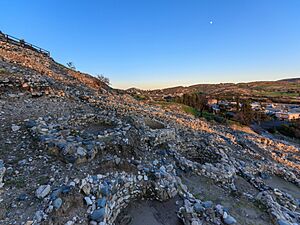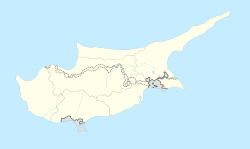Khirokitia facts for kids
|
Χοιροκοιτία, Chœrocœtía
|
|

View of Khirokitia
|
|
| Alternative name | Choirokoitia |
|---|---|
| Location | Larnaca District, Cyprus |
| Coordinates | 34°47′48.21″N 33°20′37.39″E / 34.7967250°N 33.3437194°E |
| Site notes | |
| Ownership | Cyprus Department of Antiquities |
| Management | Cyprus Department of Antiquities |
| Official name | Choirokoitia |
| Type | Cultural |
| Criteria | ii, iii, iv |
| Designated | 1998 (22ns session), modified 2012 |
| Reference no. | 848bis |
| Region | Europe and North America |
Khirokitia (also spelled Choirokoitia) is a very old archaeological site on the island of Cyprus. It dates back to the Neolithic Age, which is also known as the New Stone Age. This amazing site has been recognized as a World Heritage Site by UNESCO since 1998. It is considered one of the most important and best-preserved prehistoric places in the eastern Mediterranean region. Khirokitia shows us how people lived in an organized community long, long ago. They built a village with strong walls for protection. This settlement is a great example of the "aceramic" period, meaning people lived there before pottery was invented.
Contents
Discovering the Ancient Village
The site of Khirokitia was first found in 1934 by Porphyrios Dikaios. He was the director of the Department of Antiquities in Cyprus. Mr. Dikaios led several digs at the site between 1934 and 1946. His first discoveries were shared in a journal in 1934.
Later Excavations at Khirokitia
More excavations took place in the early 1970s. However, these were paused for a while. A French team, led by Alain Le Brun, started digging again in 1977. Khirokitia was lived in for a very long time, from around 7000 BC to 4000 BC.
Life in the Khirokitia Settlement
The village of Khirokitia is built on a hillside. It's located in the valley of the Maroni River, about 6 kilometers (almost 4 miles) from the southern coast of Cyprus. The people who lived here during the Neolithic Age were very skilled.
How People Lived and Ate
The villagers of Khirokitia were mostly farmers. They grew crops and also raised animals like sheep, goats, and pigs. They also gathered wild fruits from the area, such as pistachio nuts, figs, olives, and plums. The main animals they hunted or herded were deer, sheep, goats, and pigs.
The Village Layout and Homes
Khirokitia was a protected village. It had a strong stone wall around it that was about 2.5 meters (8 feet) thick. At its highest point, the wall was about 3 meters (10 feet) tall. People likely entered the village through a few openings in this wall.
Inside the wall, the buildings were round and built close together. The lower parts of these buildings were made of stone. They became very thick over time as more layers of stone were added. The outside of these round houses measured between 2.3 meters (7.5 feet) and 9.2 meters (30 feet) across. The inside space was smaller, from 1.4 meters (4.5 feet) to 4.8 meters (15.7 feet) wide.
For a long time, people thought all the roofs were dome-shaped. But a recently found collapsed roof showed that some buildings had flat roofs.
Inside the Round Huts
Each hut had different areas inside for different uses. There were low walls that separated spaces for working, resting, or storing things. Many huts had hearths, which were like fireplaces, used for cooking and keeping warm. They also had benches and windows. In some cases, there's proof of supports for an upper floor.
It's believed that each hut was like a single room. Several of these huts were grouped around an open courtyard, forming a family home.
Population and Life Expectancy
At any one time, the village probably had between 300 and 600 people living there. People in Khirokitia were generally shorter than people today. Men were about 160 centimeters (5 feet 3 inches) tall on average, and women were about 150 centimeters (4 feet 11 inches) tall. Sadly, many babies did not survive. On average, men lived to about 35 years old, and women to about 33.
When someone died, they were buried in a crouched position right under the floors of their houses. Sometimes, offerings were placed with the dead. This might mean they had a special way of honoring their ancestors within their families.
Why the Village Was Left Empty
The village of Khirokitia was suddenly abandoned around 6000 BC. We don't know why. After this, it seems the island of Cyprus was mostly empty for about 1500 years. Then, new groups of people, like the Sotira group, arrived. However, newer discoveries show that Cyprus was likely lived in continuously from around 9000 BC. Early communities were small and spread out, so not every area was used as much as later on.
What Does the Name Khirokitia Mean?
There are many ideas about how the village got its name. The most common idea is that it comes from two Greek words: "Khiros" (meaning 'pig') and "Kiti" (meaning 'cradle' or 'place of origin'). So, it could mean "Pig-cradle" or a place where pigs were raised.
Other Ideas for the Name
- Some people think the original name was "Sidirokitida," meaning a place where iron was found.
- Another idea is "Khirogetia," which means the practice of palm reading.
- It might also come from "Ierokitida," meaning "Sacred place."
- Some creative ideas suggest it comes from "gyros" (round) and "oikia" (house) because of the round huts.
- A local story says the name comes from "Chere Kitia," a phrase used by a queen to talk to a friend from Kition.
- It was also suggested that the name might come from a plant called "Annona cherimola," known as "Cheromolia" in Cyprus, but this is unlikely.
No matter the exact origin, old maps show the village as "Cherochetica" or "Chierochitia."
Gallery
See also











